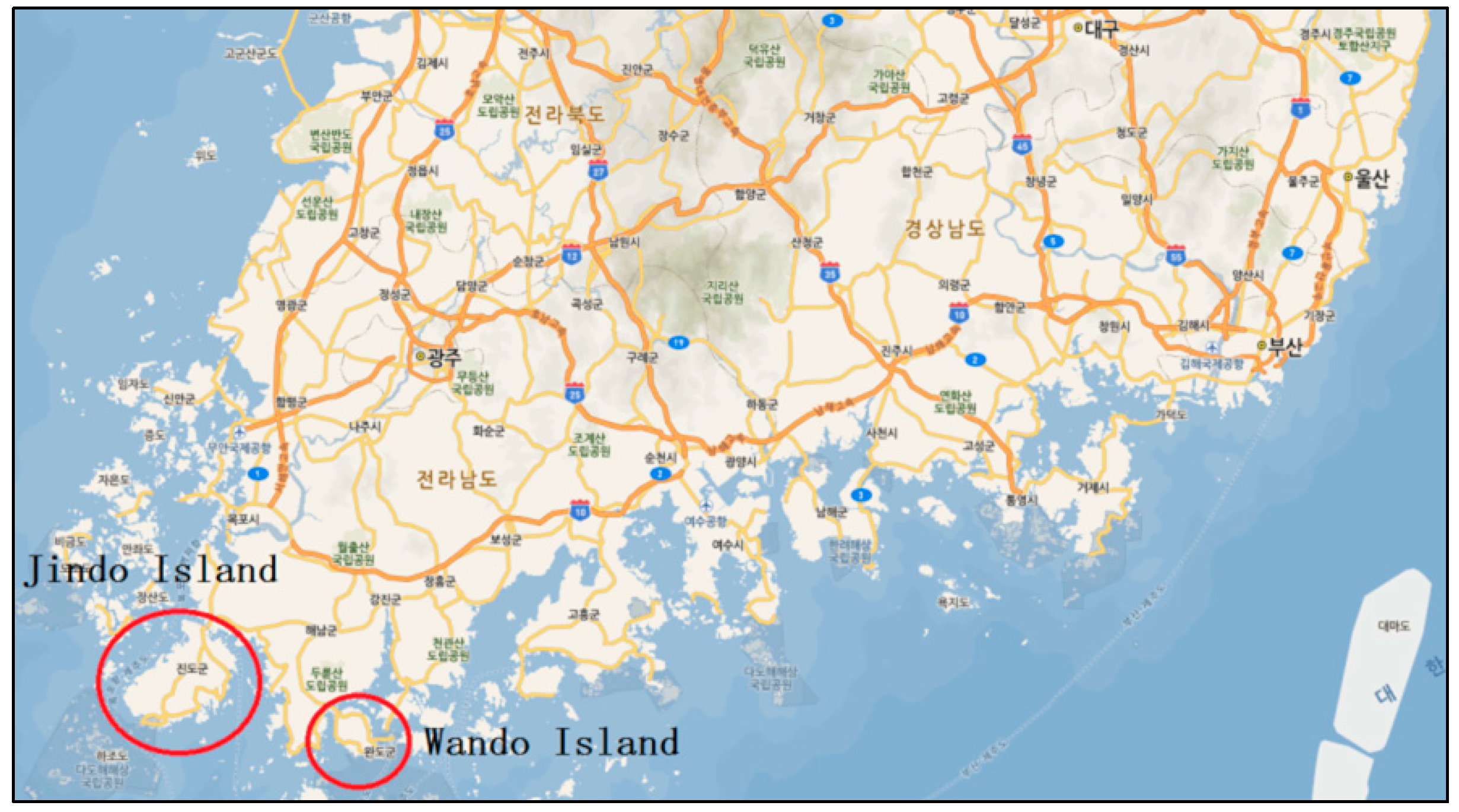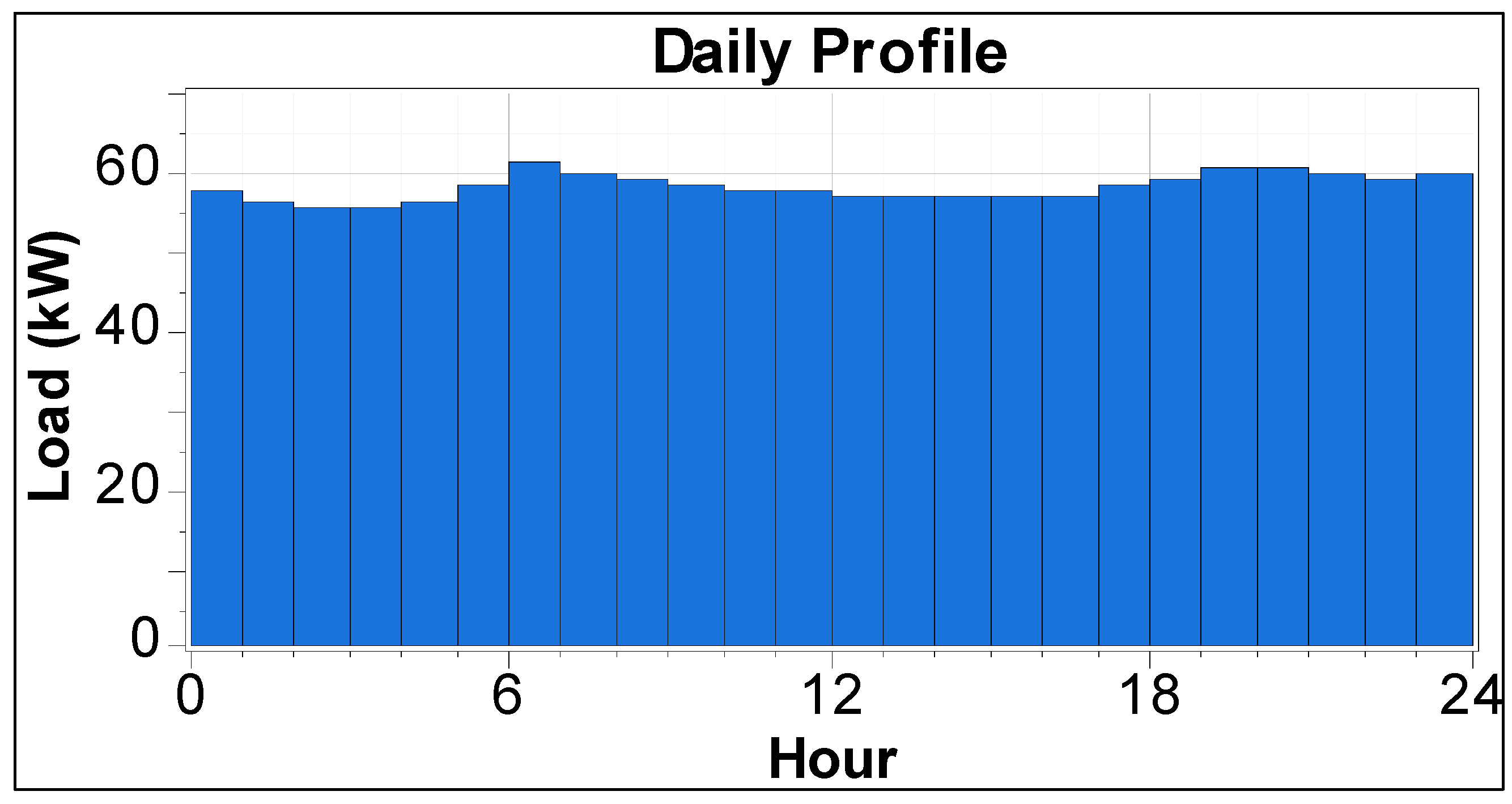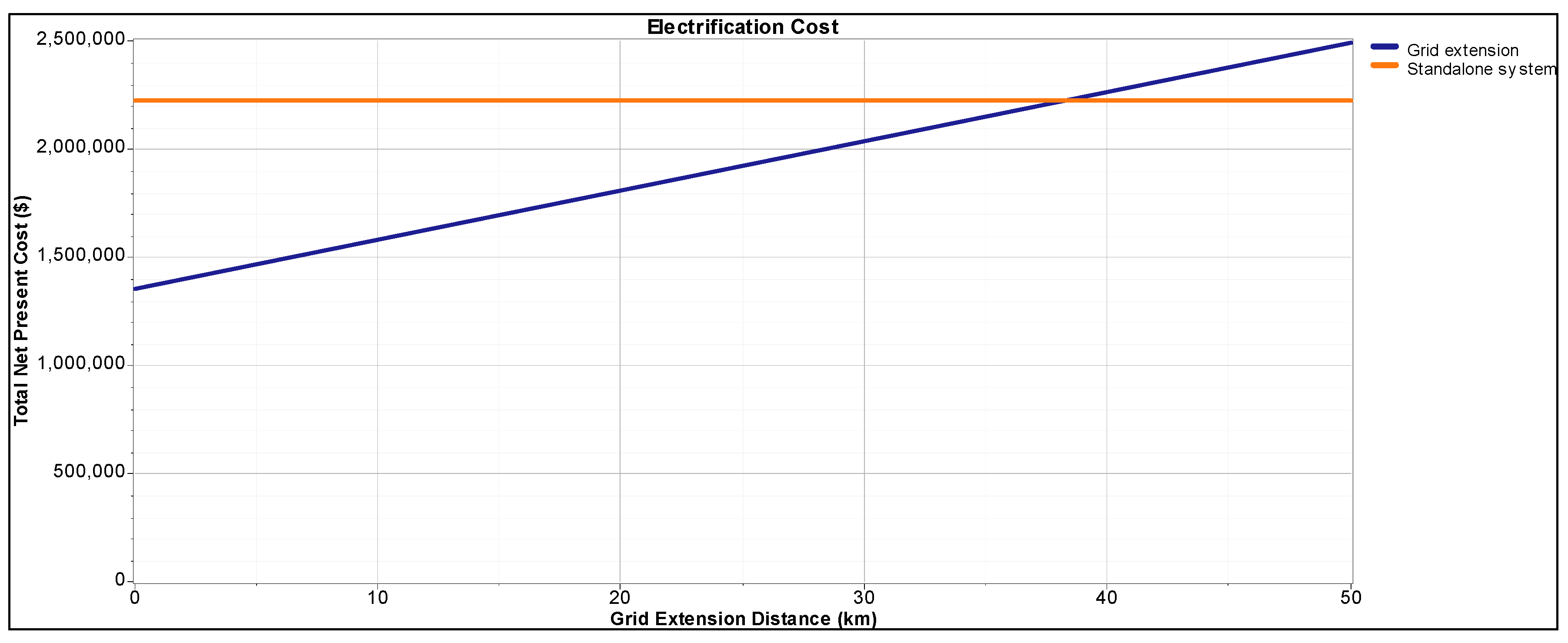Comparative Analysis of On- and Off-Grid Electrification: The Case of Two South Korean Islands
Abstract
:1. Introduction
2. System Configuration
2.1. Load Profile
2.2. Renewable Energy Resources
2.2.1. Wind Energy Resources
2.2.2. Solar Energy Resources
2.3. Background Economic Rationale
2.4. Renewable Energy Generation Systems
2.5. Grids
3. Optimization and Simulation Results
3.1. Jindo-Gun: Optimized PV-Wind-Battery-Converter Hybrid Systems
3.2. Wando-Gun: Optimized PV-Wind-Battery-Converter Hybrid Systems
4. Conclusions
Author Contributions
Conflicts of Interest
References
- Kim, H.; Shin, E.; Chung, W. Energy demand and supply, energy policies, and energy security in the Republic of Korea. Energy Policy 2011, 39, 6882–6897. [Google Scholar] [CrossRef]
- Kim, H.; Baek, S.; Park, E.; Chang, H.J. Optimal green energy management in Jeju, South Korea-On-grid and off-grid electrification. Renew. Energy 2014, 69, 123–133. [Google Scholar] [CrossRef]
- Yoo, K.; Park, E.; Kim, H.; Ohm, J.Y.; Yang, T.; Kim, K.J.; del Pobil, A.P. Optimized Renewable and Sustainable Electricity Generation Systems for Ulleungdo Island in South Korea. Sustainability 2014, 6, 7883–7893. [Google Scholar] [CrossRef]
- Baek, S.; Kim, H.; Chang, H.J. Optimal Hybrid Renewable Power System for an Emerging Island of South Korea: The Case of Yeongjong Island. Sustainability 2015, 7, 13985–14001. [Google Scholar] [CrossRef]
- Ayoub, N.; Yuji, N. Governmental intervention approaches to promote renewable energies—Special emphasis on Japanese feed-in tariff. Energy Policy 2012, 43, 191–201. [Google Scholar] [CrossRef]
- Hirschl, B. International renewable energy policy between marginalization and initial approaches. Energy Policy 2009, 37, 4407–4416. [Google Scholar] [CrossRef]
- Kitzing, L.; Mitchell, C.; Morthorst, P.E. Renewable energy policies in Europe: Converging or diverging? Energy Policy 2012, 51, 192–201. [Google Scholar] [CrossRef]
- Moosavian, S.M.; Rahim, N.A.; Selvaraj, J.; Solangi, K.H. Energy policy to promote photovoltaic generation. Renew. Sustain. Energy Rev. 2013, 25, 44–58. [Google Scholar] [CrossRef]
- Di, D.V.; Favuzza, S.; La Cascia, D.; Massaro, F.; Zizzo, G. Critical assessment of support for the evolution of photovoltaics and feed-in tariff(s) in Italy. Sustain Energy Technol. Assess. 2015, 9, 95–104. [Google Scholar] [CrossRef]
- Jenkins, N.; Allan, R.; Crossley, P.; Kirschen, D.; Strbac, G. Embedded Generation, 1st ed.; IEEE Power and Energy Series; The Institution of Electrical Engineers: London, UK, 2000; pp. 189–251. [Google Scholar]
- Asano, H.; Hatziargyriou, N.; Iravani, R.; Marnay, C. Microgrids: An overview of ongoing research, development, and demonstration projects. IEEE Power Energy Mag. 2007, 5, 78–94. [Google Scholar]
- Lidula, N.W.A.; Rajapakse, A.D. Microgrids research: A review of experimental microgrids and test systems. Renew. Sustain. Energy Rev. 2011, 15, 186–202. [Google Scholar] [CrossRef]
- Bracco, S.; Delfino, F.; Pampararo, F.; Robba, M.; Rossi, M. The University of Genoa smart polygeneration microgrid test-bed facility: The overall system, the technologies and the research challenges. Renew. Sustain. Energy Rev. 2013, 18, 442–459. [Google Scholar] [CrossRef]
- International Energy Agency (IEA). World Energy Outlook; International Energy Agency: Paris, France, 2013.
- Ryu, J.C.; Lee, S.K. Korea’s Perspective on Energy and Economic Cooperation in Northeast and Central Asia. In Proceedings of the International Symposium on Energy Resources Cooperation and Corporate Strategy in Northeast and Central Asia, Seoul, Korea, 3 July 2008.
- Lee, T.; Lee, T.; Lee, Y. An experiment for urban energy autonomy in Seoul: The One “Less” Nuclear Power Plant policy. Energy Policy 2014, 74, 311–318. [Google Scholar] [CrossRef]
- Kim, H.; Park, E.; Kwon, S.J.; Ohm, J.Y.; Chang, H.J. An integrated adoption model of solar energy technologies in South Korea. Renew. Energy 2014, 66, 523–531. [Google Scholar] [CrossRef]
- Wando-County. Available online: http://www.wando.go.kr/ (accessed on 5 November 2015).
- Incheon Metropolitan City. Available online: http://www.incheon.go.kr/index.do (accessed on 5 November 2015).
- Lambert, T.; Gilman, P.; Lilienthal, P. Micropower system modeling with HOMER. Integr. Altern. Sources Energy 2006, 1, 379–418. [Google Scholar]
- Sinha, S.; Chandel, S.S. Review of software tools for hybrid renewable energy systems. Renew. Sustain. Energy Rev. 2014, 32, 192–205. [Google Scholar] [CrossRef]
- Hafez, O.; Bhattacharya, K. Optimal planning and design of a renewable energy based supply system for microgrids. Renew. Energy 2012, 45, 7–15. [Google Scholar] [CrossRef]
- Bahramara, S.; Jafari, F.; Rahimi-Kian, A.; Lesani, H. Planning of a Grid-connected Smart Micro-power system. In Proceedings of the 2012 IEEE Innovative Smart Grid Technologies—Asia (ISGT Asia), Tianjin, China, 21–24 May 2012.
- NASA. Earth Data Atmospheric Science Data Center. Available online: https://eosweb.larc.nasa.gov (accessed on 5 November 2015).
- Katsigiannis, Y.A.; Georgilakis, P.S.; Karapidakis, E.S. Genetic Algorithm Solution to Optimal Sizing Problem of Small Autonomous Hybrid Power Systems. In Artificial Intelligence: Theories, Models and Applications, Proceedings of 6th Hellenic Conference on AI, SETN 2010, Athens, Greece, 4–7 May 2010; pp. 327–332.
- Connolly, D.; Lund, H.; Mathiesen, B.V.; Leahy, M. A review of computer tools for analysing the integration of renewable energy into various energy systems. Appl. Energy 2010, 87, 1059–1082. [Google Scholar] [CrossRef]
- Bjelic, I.B.; Rajaković, N.; Ćosić, B.; Duić, N. Increasing wind power penetration into the existing Serbian energy system. Energy 2013, 57, 30–37. [Google Scholar] [CrossRef]
- KMA. Annual climatological report 2013, Korea Meteorological Administration. Available online: http://www.kma.go.kr/weather/observation/data_monthly.jsp (accessed on 22 July 2015).
- Nema, P.; Nema, R.K.; Rangnekar, S. A current and future state of art development of hybrid energy system using wind and PV-solar: A review. Renew. Sustain. Energy Rev. 2009, 13, 2096–2103. [Google Scholar] [CrossRef]
- Lee, M. Global trends and implication for the PV industry. Korea Dev. Bank J. 2008, 631, 65–98. [Google Scholar]
- The Bank of Korea Monetary Policy. Available online: http://www.bok.or.kr/baserate/baserateList.action?menuNaviId=33 (accessed on 22 July 2015).
- Karakoulidis, K.; Mavridis, K.; Bandekas, D.V.; Adoniadis, P.; Potolias, C.; Vordos, N. Techno-economic analysis of a stand-alone hybrid photo voltaic-diesel-battery-fuel cell power system. Renew. Energy 2011, 36, 2238–2244. [Google Scholar] [CrossRef]
- Liu, G.; Rasul, M.G.; Amanullah, M.T.O.; Khan, M.M.K. Techno-economic simulation and optimization of residential grid-connected PV system for the Queensland climate. Renew. Energy 2012, 45, 146–155. [Google Scholar] [CrossRef]
- Kusakana, K.; Vermaak, H.J. Hybrid renewable power systems for mobile telephony base stations in developing countries. Renew. Energy 2013, 51, 419–425. [Google Scholar] [CrossRef]
- Ashourian, M.H.; Cherati, S.M.; Zin, A.M.; Niknam, N.; Mokhtar, A.S.; Anwari, M. Optimal green energy management for island resorts in Malaysia. Renew. Energy 2013, 51, 36–45. [Google Scholar] [CrossRef]
- Asrari, A.; Ghasemi, A.; Javidi, M.H. Economic evaluation of hybrid renewable energy systems for rural electrification in Iran—A case study. Renew. Sustain. Energy Rev. 2012, 16, 3123–3130. [Google Scholar] [CrossRef]
- Demiroren, A.; Yilmaz, U. Analysis of change in electric energy cost with using renewable energy sources in Gökceada, Turkey: An island example. Renew. Sustain. Energy Rev. 2010, 14, 323–333. [Google Scholar] [CrossRef]
- Kang, H. The emerging PV industry. In CEO Information; Samsung Economic Research Institute: Seoul, Korea, 2007; p. 616. [Google Scholar]
- Ministry of Knowledge Economy (MKE). New and Renewable Energy White Paper 2008 (in Korea); Ministry of Knowledge Economy: Gwacheon, Korea, 2008. [Google Scholar]
- Duke, R.D. Clean energy technology buydowns: Economic theory analytic tolls, and the photovoltaics case. Ph.D. Thesis, Princeton University, Princeton, NJ, USA, November 2002. [Google Scholar]
- Schaeffer, G.J.; Seebregts, A.J.; Beurskens, L.W.M.; de Moor, H.H.C.; Alsema, E.A.; Sark, W. Learning from the Sun. Analysis of the Use of Experience Curves for Energy Policy Purposes: The Case of Photovoltaic Power; Final Report of the PHOTEX Projects, ECn-C-4-035; Energy Research Center of the Netherlands: Petten, The Netherlands, 2004. [Google Scholar]
- Nemet, G.F. Beyond the learning curve: Factors influencing cost reductions in photovoltaics. Energy Policy 2005, 34, 3218–3232. [Google Scholar] [CrossRef]
- LGERI Business Insight Weekly Focus. Available online: http://www.lgeri.com/uploadFiles/ko/pdf/ind/LGBI1276-27_20131118094658.pdf (accessed on 5 November 2015).













| Component | Capital ($) | Replacement ($) | O&M * ($) | Salvage ($) | Total ($) |
|---|---|---|---|---|---|
| PV | 525,000 | 0 | 93,417 | −83,701 | 534,716 |
| BWC Excel-S | 247,500 | 208,800 | 26,691 | −131,530 | 351,461 |
| Surrette 6CS25P | 175,000 | 152,744 | 12,456 | −46,501 | 293,699 |
| Converter | 44,000 | 37,120 | 9787 | −23,383 | 67,523 |
| System | 991,500 | 398,664 | 142,350 | −285,115 | 1,247,399 |
| Component | Capital ($) | Replacement ($) | O&M * ($) | Salvage ($) | Total ($) |
|---|---|---|---|---|---|
| PV | 1,125,000 | 0 | 200,179 | −179,359 | 1,145,820 |
| BWC Excel-S | 330,000 | 278,400 | 35,587 | −175,373 | 468,614 |
| Surrette 6CS25P | 312,500 | 272,756 | 22,242 | −83,037 | 524,462 |
| Converter | 56,000 | 47,244 | 12,456 | −29,760 | 85,939 |
| System | 1,823,500 | 598,400 | 270,464 | −467,530 | 2,224,835 |
© 2016 by the authors; licensee MDPI, Basel, Switzerland. This article is an open access article distributed under the terms and conditions of the Creative Commons by Attribution (CC-BY) license (http://creativecommons.org/licenses/by/4.0/).
Share and Cite
Kim, H.; Baek, S.; Choi, K.H.; Kim, D.; Lee, S.; Kim, D.; Chang, H.J. Comparative Analysis of On- and Off-Grid Electrification: The Case of Two South Korean Islands. Sustainability 2016, 8, 350. https://doi.org/10.3390/su8040350
Kim H, Baek S, Choi KH, Kim D, Lee S, Kim D, Chang HJ. Comparative Analysis of On- and Off-Grid Electrification: The Case of Two South Korean Islands. Sustainability. 2016; 8(4):350. https://doi.org/10.3390/su8040350
Chicago/Turabian StyleKim, Heetae, Seoin Baek, Kyu Ha Choi, Dojin Kim, Seongmin Lee, Dahill Kim, and Hyun Joon Chang. 2016. "Comparative Analysis of On- and Off-Grid Electrification: The Case of Two South Korean Islands" Sustainability 8, no. 4: 350. https://doi.org/10.3390/su8040350
APA StyleKim, H., Baek, S., Choi, K. H., Kim, D., Lee, S., Kim, D., & Chang, H. J. (2016). Comparative Analysis of On- and Off-Grid Electrification: The Case of Two South Korean Islands. Sustainability, 8(4), 350. https://doi.org/10.3390/su8040350






